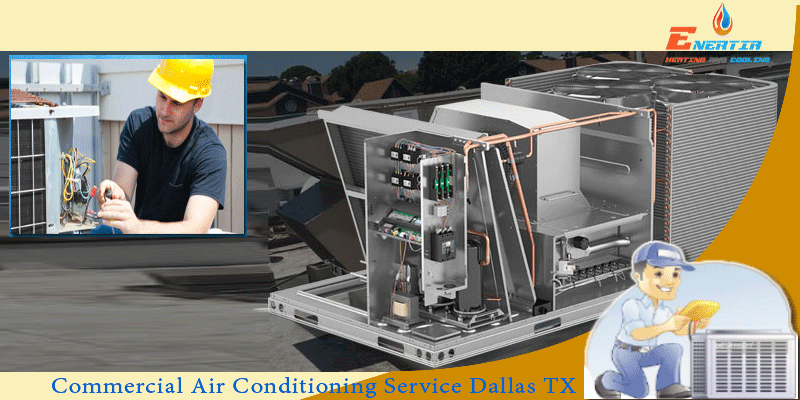 An air conditioning system in the house or your commercial space works by segregating & collecting the hot air present in the area. After this, it processes the same and releases it as cold air. Although this is the prime goal of an Air Conditioner, the complete process is actually very critical. Given the fact that it is a critical system with so many components, it’s prone to fail with lack of maintenance. In such cases, you can hire help from commercial air conditioning service, Dallas, TX.
An air conditioning system in the house or your commercial space works by segregating & collecting the hot air present in the area. After this, it processes the same and releases it as cold air. Although this is the prime goal of an Air Conditioner, the complete process is actually very critical. Given the fact that it is a critical system with so many components, it’s prone to fail with lack of maintenance. In such cases, you can hire help from commercial air conditioning service, Dallas, TX.
In essence, the processing being done by commercial Air conditioners is done with the use of 5 prime components which include:
- Compressor
- Evaporator
- Expansion Valve
- Condenser
- Refrigerant
In this particular article, we will discuss the critical functionalities and parts of an air conditioning system.
Air Conditioner Parts & Processes
Generally, the installation of air conditioners can be done in two different forms which include split AC systems and window systems. In everyday languages, it can be referred as split ACs or window ACs. Regardless of the type of air conditioner you prefer, it consists of 4 significant components listed below:
-
Evaporator:
The evaporator of an air conditioner is basically the coil that helps in the exchange of heat. It is responsible for the collection of heat from interior parts of the house through the refrigerant gas. Thus, this component is defined as an evaporator, and it is the only place where the refrigerant absorbs the heat and thus evaporates in order to attain gaseous state.
Typical gases used as refrigerant in the evaporator include HCFCs or Hydrofluorocarbons like R22 or the hydrocarbons such as R-600A and R290. This gas plays an essential role in absorbing the heat present in the room. If you ever face issues with your refrigerant, you need to seek help from commercial air conditioning service, Dallas, TX.
-
Compressor:
As clearly signified by the name, this is precisely where the refrigerant gas is compressed back to its liquid state. This segment of the air conditioning unit is fitted into the outbound unit which is the part installed on the outer periphery of your house or the office.
-
Condenser:
Apart from the compressor, the condenser is another unit that is located alongside the compressor toward the outer periphery of the air conditioning unit. The condenser acquires the vaporized version of the refrigerant coming from the AC compressor and turns it back to liquid. Moreover, it expels all the heat that is present in the coolant to cool it down to the liquid form. If you notice that your AC parts have frozen, you can confirm that there is an issue with the condenser. In such case, you need to call for immediate help from commercial air conditioning service, Dallas, TX.
-
Expansion Valve:
Also termed as a throttling device, the AC’s expansion valve can be found located amid two coil sets. These two coil sets are the hot condenser coils and the chilled condenser coils. The expansion valve is designed to keep tab on the total amount of the refrigerant that is moving into the evaporator. With window ACs, these three components are located inside the small box made of metal which is installed in the window opening.
Now that you know the prime components of the air conditioner let us take a look at how it works.
Working Principle of the Air Conditioner
A commercial air-conditioner is designed to collect the hot air present inside any space. It processes this hot air with aid from the refrigerant & some coils. After this, the cooled down air is released back into the room from where hot air was collected. This is actually how most of the air conditioning system works.
Most users believe that the AC produces cold air with the use of machines that are installed inside. However, this is actually a misconception. Your air conditioning system isn’t some magical device that generates cold air out of nowhere. It is the accumulation of chemical and physical phenomena that results in decrease of temperature inside the room.
Whenever you switch on the AC & set it to the desired temperature, your thermostat senses the temperature difference. This is when the thermostat instructs the machine to start working. The warm air inside the room is drawn in through the grille located towards the base of the AC indoor unit. The warm air then flows atop the pipes that carry the refrigerant. After this, your AC refrigerant absorbs heat & turns into gaseous state while cooling the air.
Apart from cooling down the hot air, the AC evaporator coil also absorbs heat from this incoming air and thus helps dehumidify the air from excess moisture.
Conclusion
Even though we are highly dependent on the air conditioners today, it will come as a surprise to you that they weren’t actually designed for the comfort of humans. They were initially intended to eliminate some issues that surfaced during the manufacturing of things in the publishing companies. From then to now, this machine has become an integral part of our daily lives.
Need an affordable and reliable commercial air conditioning service in Dallas, TX? Call the experts at Enertia HVAC/R and get instant solution to your AC issues. To hire our services, give us a call at (214) 550-3458 or get a free estimate by writing to us at (469) 351-9657. You can also mail us at enertiallc@gmail.com.
